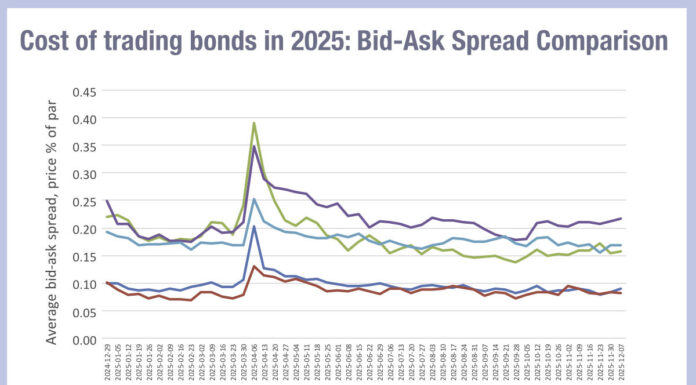Several new and evolving trends are providing access to pricing and liquidity for buy-side firms, as Olivier Cajfinger, managing director and head of global investment grade credit sales & short term fixed income distribution, at J.P. Morgan explains.
How would you describe the liquidity picture in markets today?
Over the past year, we have seen some very significant events including Credit Suisse, the UK LDI event, and the US regional bank crisis. Despite these material events, liquidity in credit markets has remained resilient. We have consistently heard our clients telling us they were able to transact in our credit markets despite this volatile environment. Anecdotally, we have had some record days in trading volume in the US IG markets. We also saw portfolio trading becoming a more mainstream tool, and more importantly, the sizes of these portfolio trades are growing. Despite the current difficult macro environment for the buy side, and less primary issuance, our markets have remained resilient and there was ample liquidity in the market to express views.
How do you see trade executions evolving within these markets?
Portfolio trading continues to grow. Trades can be increasingly sizeable and complex. We are trading more portfolio trades involving multiple asset classes; IG, high yield, MBS, munis, structured credit, and also multiple currencies. For example, we ran one trade with 16 different currencies. The hype in Europe around fixed maturity funds has also helped to push the portfolio trading agenda as clients are happy to ramp up their inflow via the tool. To that extent, in order to serve our clients even better and deliver our franchise, we have re-organised ourselves with a global hub in charge of managing and pricing requests coming in from all over the world.
Away from that, clients are also increasingly engaging us on direct connectivity/streaming protocols. Clients on both sides of the Atlantic are telling us that they would like to execute more business that way as they remain focussed on any potential operational gains & costs efficiency.
Are there any changing patterns in trade sizes?
The market is multiple times bigger than it was a decade ago. We have more clients, more issuers in the credit markets, and bigger capital structures. The range of sizes we must execute has also become broader relative to a decade ago, and more importantly, the number of trade tickets has grown dramatically. Nevertheless, the majority of the volume in size continues to be driven by institutional clients executing larger sizes.
How does the use of those trading protocols reflect the wider changes that we’re seeing in the market landscape?
The credit landscape has changed and matured a lot. The ecosystem has become more dense, and more complex.
- Firstly, we have seen the Exchange Traded Fund (ETF) market, especially in fixed income becoming more and more mainstream. The sell side has been working towards the integration of these ETF flows into both high-touch and low-touch trading through both create and redeem, and secondary ETF flows.
- Secondly, algo capabilities both on the buy and sell side have developed across the fixed income space, not only credit.
- Finally, there is structural demand for access products, such as index & ETF, and most recently, bond total return swaps (TRS) and options on both index and ETFs.
All these features help us to build a stronger ecosystem, which allows clients to find the right liquidity for what they are trying to achieve.
What is helping that liquidity picture to develop?
At J.P. Morgan we want to recycle risk quickly using all of the different avenues of liquidity that are open to us. Our clients have been asking us to create the best possible ecosystem we can by having the right low-touch and high-touch offerings, while combining them efficiently. Our job has been to continue to leverage our already historically strong institutional platform, as well as finding synergies between our high-touch cash trading and electronic trading to deliver the best service for our clients.
How are you seeing execution quality changing?
This is an interesting question. Our markets have evolved a lot compared to a year ago, and even more versus 10 years ago. Our goals and objectives remain the same: we are here to deliver our franchise and provide the best possible service, whatever market protocol the client selects while remaining agnostic. Nevertheless, while measuring execution quality is normally addressed by the buy-side community, it is clear that from an operational perspective, the execution has improved significantly. The pace of execution of portfolio trades for instance, is a fraction of what it used it to be a few years ago.
Which dynamics are actually driving clients towards changing the way that they trade?
The current opportunity set in the IG credit market is very rich, and that offers a unique opportunity for investors where the fixed income space has again become a focus and the search for income is back in vogue. An interesting dynamic within our global IG investor base is the increased usage of the special purpose vehicle (SPV) repackaging technology. It existed a long time ago as each bank had its own SPV program. In 2017, a multi-dealer SPV program called SPIRE (Single Platform Investment Repackaging Entity) was developed and has helped to democratise the usage of this technology. The platform’s strong growth over the last six years means lower costs and much greater liquidity, with currently 18 dealers on SPIRE. With this program onboarded, you can transact both single line times and portfolio trades via a standardised documentation. Whoever has onboarded those capabilities can rapidly deploy in scale to capture premium in cross-currency opportunities, positive basis or illiquid and private credit.
©Markets Media Europe 2023
©Markets Media Europe 2025













